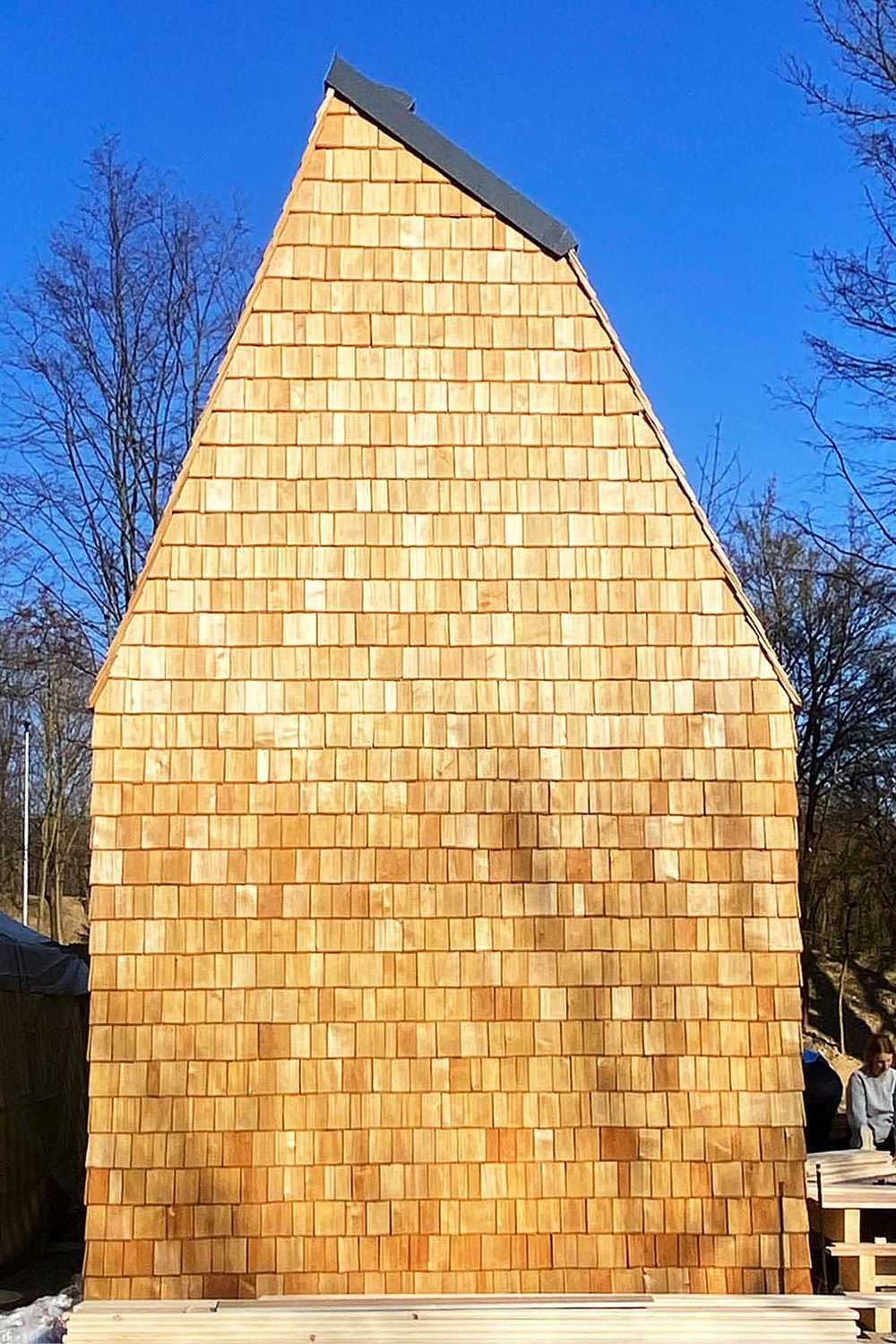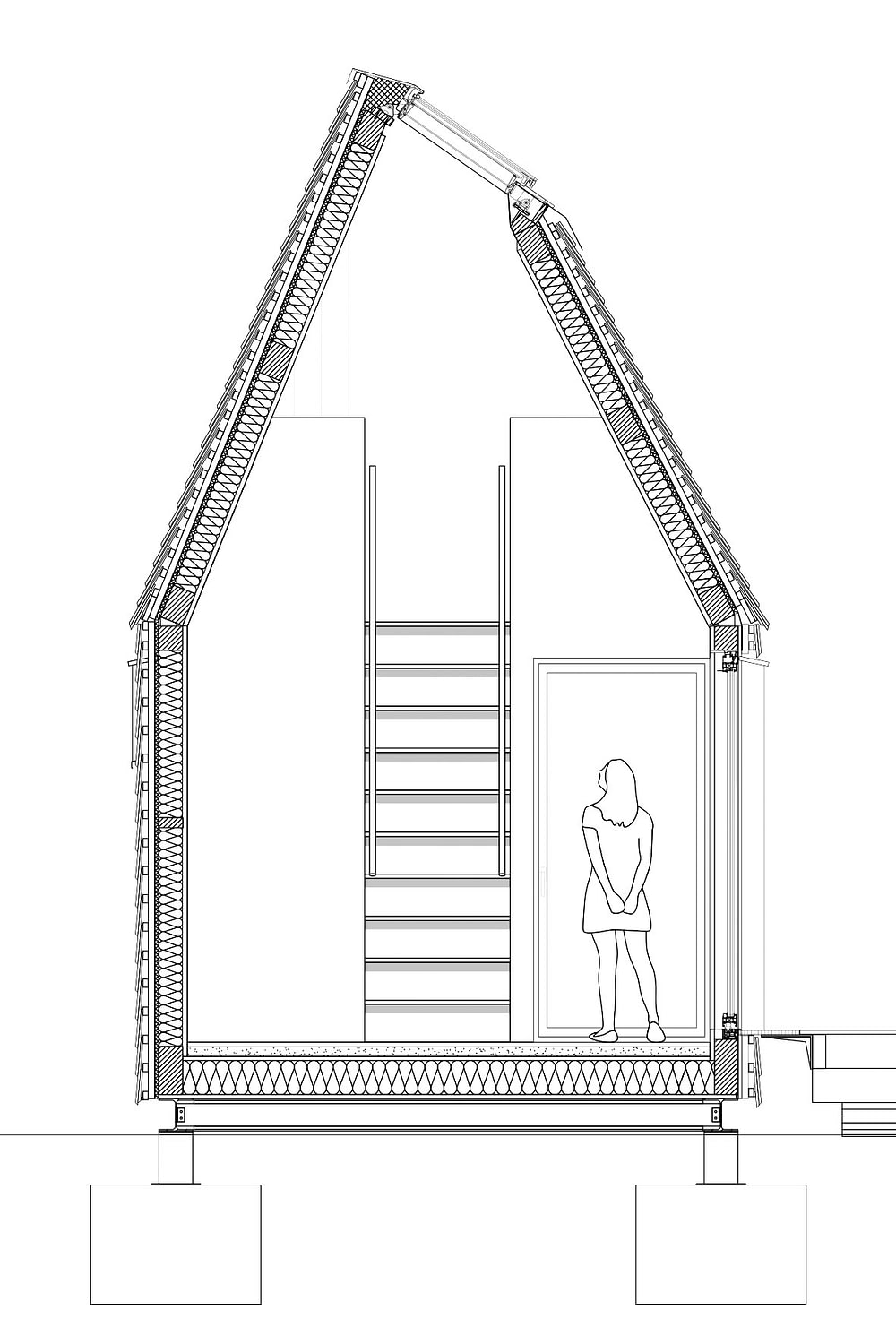Thu 15 Sep
09:30
Ludwig Wappner, KIT
Monica Tușinean, KIT
Peter Hoffmann, KIT
ttt – tiny timber tourism house
A Tiny House was developed and built on a plot of circa 25m² for the Karlsruher Campingplatz in Karlsruhe-Durlach within the context of an impromptu design task, as well as a number of associated ready-to-build seminars. The building shell was realised 1:1 together with master-carpentry students from the Friedrich-Weinbrenner-Gewerbeschule in Freiburg as a single-origin-constructed design-build project. Further workshops are in preparation dealing with the shingle facade and the interior fittings and fixtures of the house, to be executed together with the students. The Tiny House is designed to be usable and useful: upon completion, it is to be made available to visitors from Karlsruhe and flat-hunting students from the KIT.
The design concept by the winning student team is based on an abstracted form of the primeval hut motif, translated into a contemporary and functional tiny house typology. The archetypal roof has an exaggerated appearance but obtains a clarity by means of a sensibly positioned section: a south-facing skylight runs above the middle of the span of the compactly organised building, like a ribbon of light that connects the interior composition of the small architectural volume and consolidates it.
A particular goal in terms of sustainable building was to realise the design as far as possible using a single-source building technique, whereby the nodal points of the wooden structural framework were developed as a prototype together with the Chair of Supporting Structure at the KIT so as to rely on fewer metal joints than in usual connections. This intense and networked cooperation between the students, planners and craftspeople created a productive and friendly atmosphere during the building process, allowing the challenging constructional conflicts thrown up by the single-source approach to be solved and realised intelligently in terms of architecture and building skills.
The focus in this process was not to find solutions that are ‘right’ in the normative regulatory framework, rather it concerned solutions that give the correct answers from the imprecise innermost heart of the design. What in building regulatory parlance represents ‘customised solutions’ and ‘special approvals’ – i.e. the literal exceptions and deviations from the norm – also embodies the core spirit of this work, namely that experimental constructional projects can only bear fruit in close collaboration with numerable actors and an appetite for risk.
The Tiny House also transcends its original scope as a design-build project in terms of the epistemic object. The boundaries between the clearly defined roles of the students, teachers, designers and builders as actors are overlaid in the process, thus giving a knowledge gain across a spectrum that is rarely found in conventional architectural practice or in teaching. In all its details the house represents a knowledge carrier than bridges the binary caesura, described already by Alberti, between arte and mestiere. In the design and the building process alike, these oppositions – inherent to our profession – are probed and constructively solved.
Looking from further away, an observer could be forgiven for thinking that the building process ran as clearly and straightforwardly as the clear concept, the small scale and the clarity of the material would suggest. However, the numerous contrary actions that coalesce in the Tiny House revealed themselves to be a source of conflict yet complementary. The knowledge gain lies precisely in this balancing of the design and building-construction tensions, their harmonious solution making the incarnated design finally legible as beautiful architecture. In the end the appealing result is simply a silent witness to a highly complex and instructive path of development.
Literatur
Vitruvius, The Ten Books on Architecture, trans. Morris Hicky Morgan (New York, NY: Dover Publications, 1960), 38.
Boris Ewenstein and Jennifer Whyte, ‘Knowledge Practices in Design: The Role of Visual Representations as “Epistemic Objects”’, Organization Studies 30, no. 1 (2009), 7–30, here 10.
See Johannes Käferstein (ed.), Wege Zum Raum: Konstruktive Denkweisen in Der Architekturausbildung (Lucerne: Quart Verlag, 2020).
Leon Battista Alberti, On the Art of Building in Ten Books, trans. Joseph Rykwert, Neil Leach and Robert Tavernor (Cambridge, MA: MIT Press, 1991), 3.
Catherine M. Soussloff, The Absolute Artist (Minneapolis, MN, and London: University of Minnesota Press, 1997), 67.

view from east

cross section
Professor Ludwig Wappner Dipl. Ing. Architecture and Urban Planning Chair of Building Construction at the Architectural Faculty, KIT
Ludwig Wappner has taught and researched since 2010 as a full professor for design and building design at the Karlsruhe Institute of Technology, KIT. In 1993, together with Markus Allmann and Amandus Sattler, he founded the architectural office Allmann Sattler Wappner in Munich, which has been active since 2022 nationally and internationally as allmannwappner as an all-round practice dealing with important social questions and issues in urban planning, structural engineering and interior architecture in the sense of future preparedness. He is currently the chairman of the Design Advisory Boards of Mannheim and Pforzheim. He is also a member of the BDA and chairman of the Schellingstiftung in Karlsruhe. He has acquired many years of experience as a judge in competitions and adjudicator for expert reports. His work in practice, teaching and research importantly includes lectures, publications and guest assessments and workshops.
Dipl. Ing. Architect Monica Tușinean
Monica Tușinean studied architecture at the University Ion Mincu Bucharest and the University of Stuttgart. Since completing her studies at the University of Stuttgart she has worked as an architect supervising competitions and managing projects for Lederer Ragnarsdóttir Oei Architekten and Schleicher Ragaller Architekten. She was an assistant lecturer and academic assistant at the University of Stuttgart and currently works as an academic assistant at the Karlsruhe Institute of Technology at the Chair of Design and Building Construction. In 2019 she acquired her PhD with the Design-Based Doctoral Programme at the TU Berlin, focusing on the non-invasive transformation of existing architectural stock and industrial architecture.
Dipl. Ing. Architect Peter Hoffmann
Peter Hoffmann studied architecture at the Karlsruhe Institute of Technology, KIT. After graduating under Prof. Renzo Vallebuona in 2013/14 he worked for Prof. Peter Krebs, Büro für Architektur in Karlsruhe, initially as an apprentice architect and then until July 2018 as a supervising architect and project manager in all the work phases of church buildings, community centres and competitions. From October 2015 to March 2017 he served as a student assistant, and since April 2017 he has been an academic assistant at the Chair of Design and Building Construction at the KIT. Besides his teaching duties at the KIT, Peter Hoffmann also works as an independent architect under the office name Schneider Hoffmann Architekten in Karlsruhe.